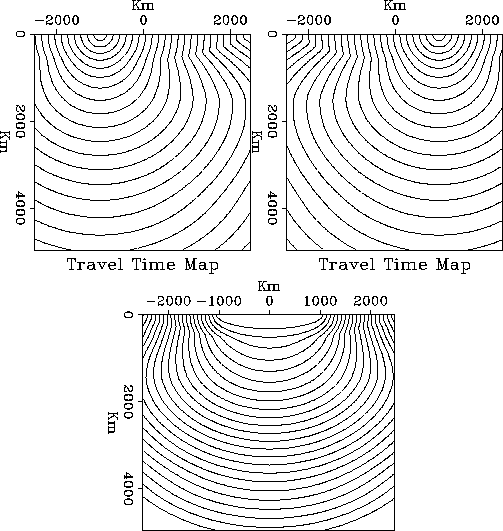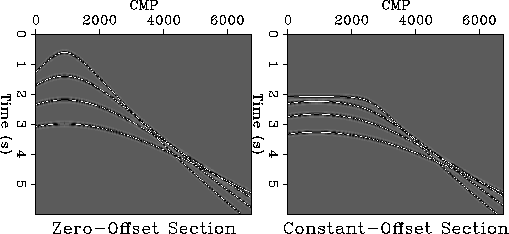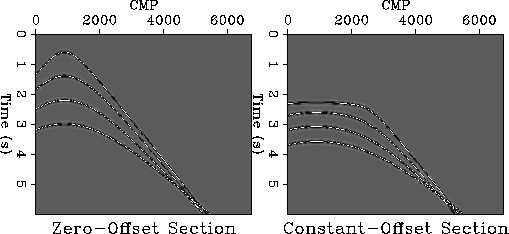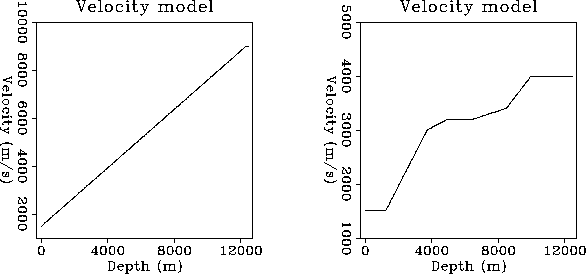




Next: MZO and DMO in
Up: MIGRATION TO ZERO-OFFSET
Previous: MIGRATION TO ZERO-OFFSET
Spreading data along the MZO impulse response is identical to
summing along a conjugate curve.
For zero-offset migration in a constant velocity medium, this is
equivalent to saying:
spreading the data over circles produces a result identical
to summing along hyperbolas.
From a computational point of view, the spreading operator (ellipse
for DMO, circle for constant velocity migration) is a ``PUT'' operator,
meaning that the operator takes a time sample and puts it in all the
adjacent traces. The conjugate summation operator (hyperbola for constant
velocity migration) is a ``GET'' operator because it gets the
input from the adjacent traces.
By using finite-difference travel-time maps, both the ``GET'' and ``PUT''
operators can be calculated in very similar ways:
- 1.
- Compute a travel-time map for the source given a velocity model v(x,z).
Figure 1a is an example of a travel-time field calculated with the source
located at X=-1000.
- 2.
- Compute a travel-time map with the source in the receiver location, given
the same velocity model.
Figure 1b is an example of a travel-time field calculated with the receiver
located at X=1000.
- 3.
- Sum the two travel-time maps. In each location of the grid we have
the sum of the travel-time from source to receiver Tco(x,z).
Figure 1c is an example of a constant-offset travel-time field
calculated by summing the source and receiver travel-time fields.
- 4.
- The gradient of the constant-offset travel-time field Tco(x,z) is
a vector which has the same direction as the zero-offset ray.
In other words, the vector perpendicular to a constant-offset
isochron bisects the angle between the ray coming from
the source and the one returning to the receiver.
This is obvious for some people, however, I
demonstrate this proposition in the Appendix.
Therefore, by calculating the gradient of the constant-offset travel-time
map in each point of the grid, we can find the ray direction for
the zero-offset case for each grid point.
- 5.
- Using the gradient table we can compute for each grid location
the surface coordinate of the zero-offset X0(x,z),
which is equivalent to finding
the intersection of the surface with the zero-offset ray.
- 6.
- Using the gradient table we can compute for each grid location
the zero-offset travel-time T0(x,z) along each zero-offset ray.
The algorithm is identical up to this point for the two conjugate operators.
At this time there are three tables for our grid velocity model:

Rayabc
Figure 1
(a) Travel-time from a source located
at X=-1000. (b) Travel-time from a source located at X=1000.
(c) Isochrons for a constant-offset model (h=1000).

The PUT operator is obtained by associating for each value of Tco(x,z)
a pair of coordinates (T0(x,z),X0(x,z)). In other words, for a given
value of the Constant-Offset Travel-Time, we find an isochron
Tco(x,z)=th=constant of coordinates
(x,z) and the values of the X0(x,z) and T0(x,z) associated with
that curve. The resulting operator is a function of X0(x,z) and T0(x,z)
and a parameter th=Tco(x,z)=constant. Therefore,
we can write it in the form
P(T0(x,z),X0(x,z);th) where the parameter th fixes the
curve Tco(x,z)=constant.
The GET operator can be defined in a similar way
by associating for each value of T0(x,z)
a pair of coordinates (Tco(x,z),X0(x,z)).
In other words, for a given
value of the Zero-Offset Time Field, we find an isochron
T0(x,z)=t0=constant of coordinates
(x,z) and the values of the X0(x,z) and Tco(x,z) associated with
that curve. The resulting operator is a
function of X0(x,z) and Tco(x,z)
and a parameter t0=T0(x,z)=constant. Therefore,
we can write it in the form
G(Tco(x,z),X0(x,z);t0) where the parameter t0 fixes the
curve T0(x,z)=constant.
From the above formulation one can see the two operators (PUT and GET)
are conjugate (adjoint)
operators.
In practice, I obtain the PUT operator using a binary search algorithm in the
table Tco(x,z) ( the binary search is possible because the velocity model
is depth variable v(z))
and I store all pairs of values (T0(x,z),X0(x,z))
corresponding to an input time sample,
which allows for all possible triplications in the operator.
For a laterally varying velocity the binary search can be replaced
with a linear search.
The GET operator is obtained using a binary search algorithm in the
table T0(x,z) and by storing all the pairs of values
(Tco(x,z),X0(x,z))
corresponding to an output time sample.
model16
Figure 2 Zero-offset section and maximum
constant-offset section for the constant gradient velocity.
 model46
model46
Figure 3 Zero-offset section and maximum
constant-offset section for the depth variable velocity.
 Velm1m4
Velm1m4
Figure 4 Velocity models for the
two cases considered.






Next: MZO and DMO in
Up: MIGRATION TO ZERO-OFFSET
Previous: MIGRATION TO ZERO-OFFSET
Stanford Exploration Project
12/18/1997





